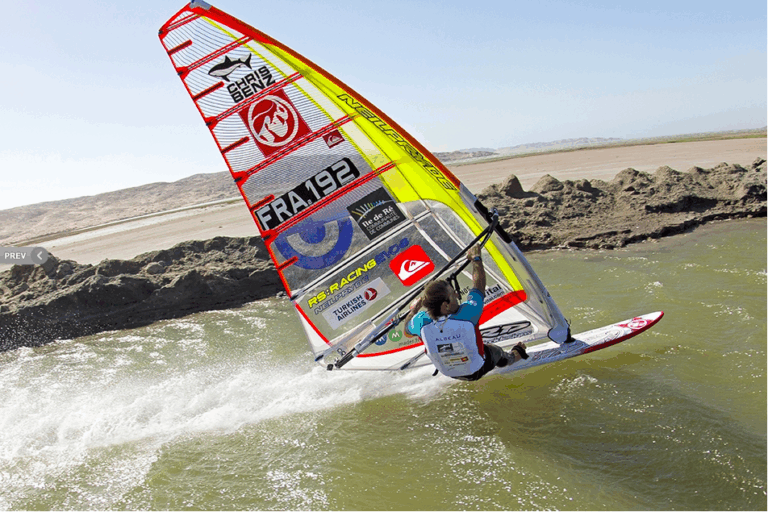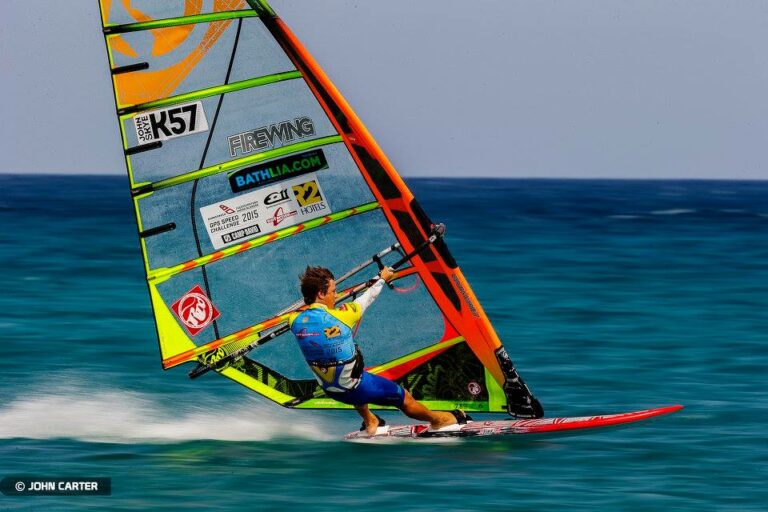In the final print issue of Boards magazine, we introduced our ‘Great Speed Debate’ and the 2015 Speed Board Test, that is now all online right here on Boards.co.uk. Now, we can release the full speed discussion with the world’s top shapers – the first four questions are up, more to come soon!
“When you think of a speed board you might imagine a tiny needle that needs 40 knots of wind and a lot of skill to even waterstart, but that simply isn’t the case anymore. Speed boards come in all sizes now, up to and over 50 cm wide. But, at this size, what is the difference between these and a similar sized slalom board?”
The world’s top shapers join Adrian Jones to discuss the benefits and differences of these ‘big’ speed boards.
[series align=’right’]
The Shapers
Tabou – Cedric Bordes (Head tester)
JP Australia – Werner Gnigler (Shaper)
Mistral – Anders Bringdal (Rider and brand manager)
Starboard – Remi Villa (Shaper)
Patrik – Patrik Deithelm (Rider, shaper and owner)
Fanatic – Sebastian Wenzel (Shaper), Peter de Wit (Head tester)
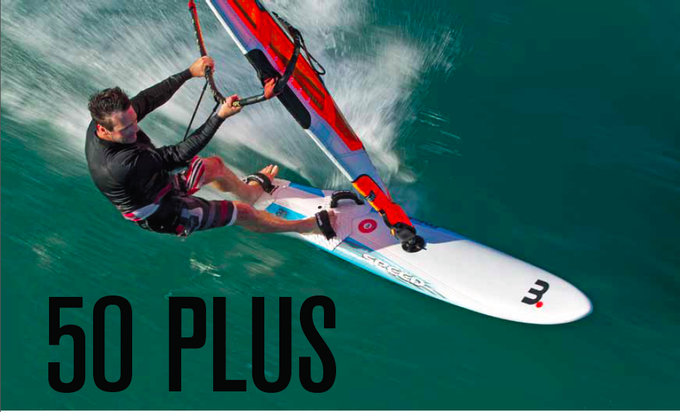
- Tabou – We have a 48 and 54 Speed Manta in the range. These two boards are for top pro and local riders, plus speed addicted amateurs. The two sizes are dependent on wind conditions – not on body weight. I am using both dependent on my sail size.Who do you design these 50cm speed boards for? It seems that the professionals are only really using the smaller sizes (and customs), so are these 50cm boards designed primarily for amateur sailors? If so, are they ‘de-tuned’ from the smaller sizes?
The reality is that with the new design boards, sails and fins the average sailor is not so average anymore… they fly.
JP Australia – They are also full on speed boards. Obviously, the speed guys want to break the record but a lot of the time the conditions are not suitable to make record runs. There is always an event winner and day winner. So, no matter what conditions you find you need a competitive board. The real small boards are only used in perfect conditions and have only about 41 cm width. The 50 is also a full on speed board.
Mistral – From our side, at Mistral we more look at board to sail ratio. For me the 50cm board is the 47cm from us. It carries 5.0 to 7.0 sail at performance standard.
We design the boards for the market we have. I do not see the issue with making the boards for ‘amateur sailors’. Today in Germany/Holland/France/Australia and the UK the guys we sell the boards to, supposedly the amateur sailors, they call back asking something like: “If I go from a 24cm asy to 22cm asy on the 5.8 can I make it to 42-45 knots? The reality is that with the new design boards, sails and fins the average sailor is not so average anymore… they fly. A de-tuned speed board has nothing to do in their hands.
We have been able to make the boards longer to help the overall performance range. But as they get lit, you lock and load and if you decide to pull the trigger they are off.
Starboard – Actually the 49 and 54cm were design by Bjorn Dunkerbeck with Carlos Sosa, this board was design for speed contests in medium winds – held in general in flat water conditions. The 50 is mostly used with 6.2 and 7.0 what ever your weight is but of course a heavy and light racer will not use it at the same time. All our Pro are using production boards is only in Luderitz with 44cm wide they have proto because at this time the board was under development but now this board is in production too.
Patrik – For the 50cm I guess the best sail is the 6.2 and can be use with 5.6 and 7.0 with very good result.
Fanatic Seb – As in any other discipline, speedsailing is performed in a variety of conditions…not only in super strong winds. Sometimes conditions are gusty or the wind is not as strong. A super narrow board makes it very hard to score good speeds consistently. So, for those conditions, you should use a 50cm wide speed board; even our pro riders do that.
Fanatic Peter – for competition use. For records the riders tend to go to spots with winds over 30 knots, and speeds over 80km/h, whereas the 50 can be used in conditions where speeds are around 70 already and the wind is just over 20 knots. In competitions the conditions are hardly ever ideal so you need a board that can make the most of it the range and ease of use of the 50cm boards make it a very versatile size.
- What is the biggest limiting factor to a boards top speed?
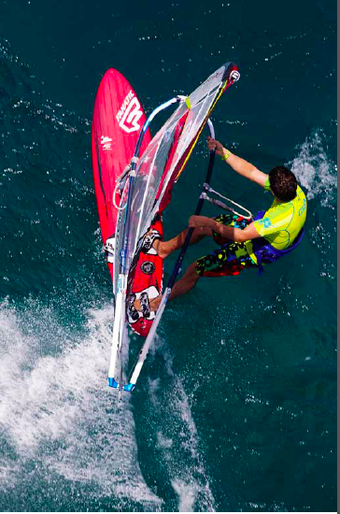
Fanatic speed board in action.
Tabou – The water contact.
JP Australia – I guess it is the chop. The flatter the water the smaller the boards can be. We need to reduce drag and the only way to do this is to make them smaller. On the other hand, you still need to be able to start them and keep them under control. So, the size is limited to the conditions. It will always be a package deal: board, rig, fin. We just need to find a way to reduce drag and control the package.
Mistral – The tail pressure pushing the front of the board down. This shows a lot as the boards get shorter. Due to the rider not being able to push the tail/fin back down the chop start to hit the curve of the rocker in the front. Either you do not go so fast or worse your board will start to bounce nose up in the chop… and you’re done.
Starboard – I would say the drag and messy wind close to the surface. One day maybe we will be on a foil with less drag, more clean wind and more speed.
Patrik – Actually, since my last run in Luderitz I am a bit confused. Just for fun I tried a 6.3 sail with my Speed 39 I normally use with 5.6m sail fully powered and I did 48.77 knots. After I barely could manage to start and get going in about 25-30 knots. I actually could not believe it and to me it proves that the board has a bite range of use and we might need to work on the sails a bit more rather then on the board. But just looking at the board the biggest limiting factor is the chop. The flatter it is, the faster you go.
The flatter it is, the faster you go.
Fanatic Seb – I think it is a combination of all factors: guts, drag of the rig, the fin and of course the board; but, I guess the board has the smallest impact in the end.
One of my shaper colleagues once said: The board is only the connection between the fin and the rig…there is something to it.
Fanatic Peter – The rider… and the conditions! We have seen 60cm boards fly over 80km/h, with the right tuning a big board can reach extreme speeds in the right conditions (little chop good wind angle) whitout any doubt the controlability and bottom shape of a 50cm has a big effect on how much a rider can get out of it.
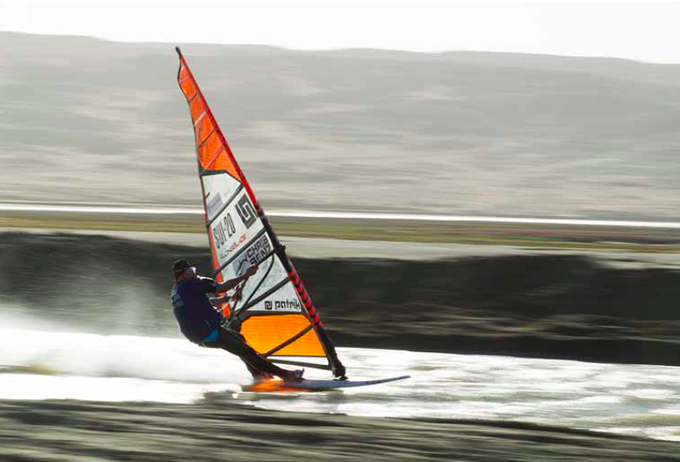
- Over the past 25 years, we have seen top speeds increase by around 10 knots (about 20% increase). Do you think we will make roughly the same progress over the next 25 years?
10 years ago we did not think we could hit 50 knots on the 500; today it is business as usual.
Tabou – Hard to know, we can probably increase speed for sure specialy if we manage to go over he water with some stable foil but 10 knots is a lot.
JP Australia – I guess so, as long we have events and ambitious riders who push the development. Also, the finance to back up the development.
Mistral – Today the peak speeds are in the 54 knot range. Will be fun to see what our kids will take it to! 10 years ago we did not think we could hit 50 knots on the 500; today it is business as usual.
If we can control the water surface as much as possible and add more wind… 60 knots will fall. For now what we think is that the barrier of normal foils and supercavitational foils may be coming close.
Starboard – I am not ‘Yes I think it is possible’ but with new concept, maybe foil or something similar we can. Just have a look how suddenly sailing boats progressed just by changing their speed concept approach 😉
Patrik – I actually believe we can go much much faster. As far as I know it is only the power joint which is defines a windsurfer. We could actually just copy the Sail Rocket and find a way how to hold on the sail with a power joint and we would also go over 60 knots. Also, we could work on foils etc but for me it is not about just being the fastest sailing craft but to be the fastest with the normal equipment a windsurfers is using.
Fanatic Seb – I am not sure about 20%, as steps tend to get smaller, but I am sure we will improve speeds over the next 25years.
Fanatic Pete – I have come to conclusion that I can fly over 90km/h on the Falcon Speed 50 with the right sail/fin. I think the new asy fins might just be able to increase the speed even more but think 20% is a fair bit!
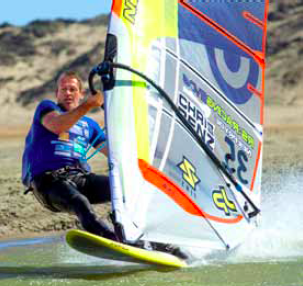 Do you design these 50cm boards with control in mind or do you rely on the water being flat enough not to have to worry about this?
Do you design these 50cm boards with control in mind or do you rely on the water being flat enough not to have to worry about this?
Tabou – Control is the key so it always take an important part.
JP Australia – Speedboards are always designed with control in mind. You don’t want to lose control on a speed strip. Flat water is always relative.
At 50 knots even the smallest ripple can get you into trouble. We always look for a loose board with good release which handles well and is forgiving.
Control is everything. If you do not have control, you cannot go fast. And let’s face it, the water is rarely perfectly flat. Not everybody has canal at their home spot…
Mistral – Any windsurfing board flying off the wind in chop bigger than 20 cm or so is a bit sketchy at best. We make our boards with as little curve as possible – this makes them perform the best possible way in the chop. This is helped greatly by the length of the board. We are around 240 now. If I was to carve out 20-25cm. (Nose rocker is almost the same for all as you need not to put the nose in the wave in front.) With this 20-25cm less I’ll end up with more curve in my rocker under the mast base and forward. This is the worst thing you can have in chop as it makes the board bounce around and lose control.
The main problem we get in chop is that we do not hang on the fin anymore. You have got to rely on the board to stay flat even when hitting waves.
Starboard – For 2016 we will completely change the concept; our 58, 55 and 50cm wide are speed boards – but also slalom boards. Until now our speed boards were exclusively design for flat water, but now you can use them in open ocean and slalom. We hope this will increase the sales that are very low for this existing extreme product.
Patrik – The best speeds are always made in flat water and it is very important for all speed sailors to find the most flat spot possible. Our boards are shaped for flat to small chop and with different fin design you can gain some extra control but in hard chop I still believe a small slalom board is better.
Fanatic Seb – Control is everything. If you do not have control, you cannot go fast. And let’s face it, the water is rarely perfectly flat. Not everybody has canal at their home spot…
Fanatic Pete – control is everything in speed. The board needs to be tuned so you can actually fly fully sheeted in at speeds over 80 km/h. To make this possible the board needs to be as neutral as it can, so whatever the gust/chop/wind angle the rider needs to feel confident to push.

- Does board weight have much effect on the speed of these boards?
Tabou – In windy conditions when you are fully powered the weight is not so important, but in gusty winds or when you need quick acceleration at the entry of a run it is important.
JP Australia – Not really, they are so small and light anyway.
Mistral – I do not think it makes any performance difference at all. The fact is they go so fast that they are on top of the water anyway. From my side I prefer to build them strong, they do get beaten the living daylights out of them. Sure in an accelerating situation the weight matters but for speedsailors this part is less important as you sail so stacked, you will accelerate like a bat out of hell anyway..
Starboard – Yes, board weight always has an importance to stay connected to the wind and not have delay between gust and acceleration. If you have a heavy board in speed you may catapult more easily in a gust if the board doesn’t accelerate immediately.
I think it is easier to sail fast when you weigh more, but you are never safe going up against talent – big or small.
Patrik – Everything matters and the higher the speeds more the details matter. My Luderitz speed boards were about 3.2 kg but I am currently planing a hollow speed board that is only about 2 – 2.5kg to be able to start and get going earlier and have more “hover-effect” when sailing down the speed run. Our production Speed boards are the lightest for their size; less is not really possible except when compromising strength.
Fanatic Seb – Not so much as on other boards (as in speed you usually do not have an issue getting planing). We actually make our boards a little heavier, stronger and stiffer.
Fanatic Peter – Well, the 50cm has a relatively high weight to volume ratio if compared to lightwind machines this is needed to cope with the impact of chop at extreme speeds. We have seen boards delaminate after severe beatings so strength is more important than weight…the impact is comparable to big airs on wave gear.
- How much difference do you think the sailors bodyweight makes to the way the board will handle? Do you consider this in the design or do you design only for the heavier speed sailors?
Tabou – Weight is quite important to go fast but it is also hard sometimes for a heavy rider to waterstart, get on planing etc… our designs are for normal riders, noting radical or with too small a wind range. I am using them and I am 90 kg.
JP Australia – Speedsailors are not lightweights anyway. We just make various sizes and a smaller rider can just use a smaller board, which is an advantage. Other than that we do not pay much attention to the riders weight.
Mistral – Same deal here, with boards that stay flatter on the water with fin tails and a V that make them fly a little it means they are fast for bigger and smaller sailors as well. Just look at Eric Beale; not an ounce over 70 kg all wet and at Luderitz last year he was around 2-4 knots off my pace. Beating the old record of Bielak in the process. But he is good. I think it is easier to sail fast when you weigh more but you are never safe going up against talent, big or small.
We do see however that the boom front is getting lower and harness lines are getting longer. This helps you keep your body low and as far away as you can from the rig. All to help control the power.
Starboard – A heavy weight racer can’t use the same board and same sail at the same time with the same conditions as a light racer – who will always take smaller gear. So, boards are designed for everyone, you just need to choose the right one for your body weight and the conditions.
Patrik – Normally the best is when a speedsailor is on the smallest board and the biggest sail he could possibly start – without using any extra weight. Once you are on the smallest board you can put on extra weight so that you are still on the limit to start the board. Looking at all the top speed sailors I am definitely the smallest and lightest guy who managed to go over 50 knots, but I am also the guy who rides the smallest boards. Also, in the year when I became Vice World Champion I was using the Speed 43cm with a 6.8-7m sail without any extra weight when everyone else used 48-55cm wide boards with 7.5-7.8m sails. Not to forget the last day in Luderitz when I used the Speed 39cm with a 6.3m2 and managed to do 48.77 knots!
Fanatic Seb – We offer a range of speedboards that cater for everybody. A lighter sailor can use a smaller board. Typically the speedsailors are big guys though…and a strong, heavy guy can usually control the board better. But we design boards for everybody…easy to use. That has always been my philosophy.
Fanatic Peter – The 50 is the light-wind speedboard for lighter guys and the mid-wind board for the heavy guy so there is a different range of use and, of course, the lighter guy needs to put the straps a bit more forward on the board to be able to trim the board the same as a heavy guy. With the right tuning the light rider can benefit from the controllability of the speed 50 big time!

- Apart from the obvious difference of width, what different design elements go into a speed board over a small slalom board?
Tabou – They are quite differences because the goal of our Manta Slalom 59 and 61 are to be easy to sail and have nice feeling on strong wind. The goal of our Manta speed 48 and 54 are to go as fast as possible with great acceleration. So, rockers, outlines and tail kick etc are all different.
JP Australia – The best example is our Speed SL 55, compared to the previous Speed 54. The speedboard is just thinner, has less nose rocker and a slightly smaller tail. It caters more for speed runs but the rest of the bottom shape is very similar. The thickness is a big issue on speed boards.
Mistral – Look at the similar volume. My 91 litre slalom board (57cm wide) is designed to sail slalom, angles of max 125 deg to square with 25-50 knots wind and sails 5.0 to 6.4 (7.0 for certain riders with skill).
Our 95 litre speed 55cm wide is designed to have less tail lift and is for 120-140 degrees off the wind; sail size 6.4 to 7.8 m sail with 15 to 25 knots of wind.
Sailing a square course on the speed board will lift the nose and you will not have enough power off the tail.
Sailing deep reaches on the slalom board will mean too much tail pressure and the board will ride with to much wetted surface.
Starboard – They will be no difference for 2016; the iSonic Speed Slalom 80, 75 and 70 will be dedicated speed boards, but also high wind slalom boards. Only the iSonic Luderitz Speed Special who will be a pure speed board – made especially for extremely flat water and trying to break the record.
Patrik – On most speed shapes the tails are narrower, the rocker lines have a flatter entry and the tucked under edge is less tucked in, with sharper rails. The bottom shape I personally keep pretty much the same, and also strap and mast track position is identical. On my designs I lower the back foot and raise the front foot on the deck shape which gives a much more comfortable position on the downwind course.
Fanatic Seb – Rockers are slightly flatter, the outline more straight / parallel. Also, we try to recess the mast foot as much as possible. We try to avoid strong bottom contours to make the shape perform as neutrally as possible.
Fanatic Peter – the control of a narrow shape is greatly influenced by the bottom shape and after that a deeper mast recess can add control in gusty conditions. When on a tight reach gaining speed for the downwinder or when trying to improve the NM speed (less deep downwind) the recess works wonders for boardspeed.
8. If the water is flat and you are pointing off the wind, will a dedicated speed board always be quicker than a small slalom board?
Tabou – Almost every time a speed board will be faster even if with slalom board you can be super fast too. So, on a dedicated run with correct wind, the speed board will be faster on GPS top speed.
JP Australia – Yes, the thinner profile and less nose rocker creates less resistance.
Mistral – Yes
Starboard – Slalom boards are easier to go upwind on than speed boards due to their shape, but also due to different fins. Slalom boards will go upwind better and will be more constant in speed.
Patrik – It depends on the water state. if it is flat yes but if it is choppy and you can not control the speed board then the Slalom board could be faster.
Fanatic Seb – I don’t think you can answer like that. It depends too much on the conditions, fins etc… but we do know that it isn’t always the smaller boards that go faster. A lot of the speed sailors actually use slalom boards. But if the conditions are super flat and the wind is not gusty, the speed board will be faster.
Fanatic Pete – Personally I like to see it like this: if boardspeed is over 60km/h a 60cm board is a good choice, when speeds are over 70km/h you can step down to a 50cm board and when speeds are well over 80 the specialist 44cm machines come out to play. So, not the other way around…I want to be fast so I will pick the 44cm!

- Why do you think we don’t see more of these boards getting sold? With the increased popularity of GPS speed over recent years, it seems strange surely? Do you think people expect then to be too hard to sail?
Tabou – It can be the reason! Even if these boards are not extreme and quite accessible, even if they don’t have a lot of volume, they are less radical than a 65-litre pintail waveboard from back in the day!
JP Australia – No, they are not hard to sail you just need the right conditions, not many people sail on speed strips. I believe a lot of people want to be faster than their friends at their local spot – therefore they join the GPS site. Then you can compare times on the day you sailed with others, tune your equipment and work on your speed.
Only few people go all the way – buy speed boards and travel to dedicated speed spots.
Mistral – In the overall picture the speed is still not as big a market but we do sell enough boards to warrant carrying on the programme. I would even say we are doing quite well in fact.
Starboard – This is exactly the reason we have decided to have the 58, 55 and 50 available for slalom too, to increase sales but also so the boards are easier to use in chops as it’s not everywhere in the world you can find super flat spot.
Patrik – I think the GPS ranking is very much oriented on “who is the fastest in the world” and not so much “who is the fastest on the spot” and sure the guys who live close or at least are able to travel to the good spots will have speed boards but all the rest I guess just have slalom boards. If “the fastest on the spot” would have more value I think we could produce more speed boards for different spots and sell more.
Fanatic Seb – Well, GPS Speedsailing is gaining popularity, but it is still very specific. You need very special conditions, so that limits the occasions of going out there and blasting. You need to have a pretty flexible schedule as a speedsailor. And even though the new generation of speed boards is more versatile, than in the old days, the range of use still sort of limited.
Fanatic Peter – Maybe these riders do not get to ride in 20 knots of wind on chop or flatish water? Other than that there is no reason not to use the 50cm speedboards as they can handle bigger speeds before you bear off.
- What do you think is the ideal sail size for this size of board (50ish cm) and what is the realistic, useable sail range?
Tabou – Best would be between 5.2 and 6.4, but you could stretch it to 7.1 too.
JP Australia – Ideal sizes are up to 6.2 but a 7.0 m is possible too on flat water, but pushing the limits.
Mistral – Mistral 47cm x 73L = sail size 5,0-7,0 Fin size symmetrical 23-28cm Assy fins, 21cm-25cm.
Mistral 55cm x 95L = sail size 6,4-7,8… ( 8’6 for some Swedes… no comment.. but they still do 40 knots with it…) Fin size symmetrical, 28-32cm Assy fin 24cm – 30cm.. (32cm for the 8’6).
Starboard – For the 50cm I guess the best sail is the 6.2, but you can be use with 5.6 and 7.0 with very good result too.
Patrik – Sure it depends on the shape of the board and the style of the rider but I believe the most comfortable sail size for a 50cm wide speed board is between 6.5-7.0m. Below is an overview of sail/board sizes I know top riders used in competition.
– up to 34cm: Best <4.6m2, max 5.2m2
– 35-38cm: Best 4.5-5.2m2, max 5.6m2
– 39-42cm: Best 4.9-5.6m2, max 5.8-6.3m2
– 43-46cm: Best 5.4-6.5m2, max 6.8-7.3m2
– 47-50cm: Best 6.3-7.0m2, max 7.2-7.6m2
– 51-54cm: Best 6.8-7.3m2, max 7.5-8.0m2
Fanatic Seb – As you can check on our website we recommend 4.5 – 7.0 sails. We keep our information here very realistic. But it also always depends a little on the sail brand you use, as they all behave differently.


